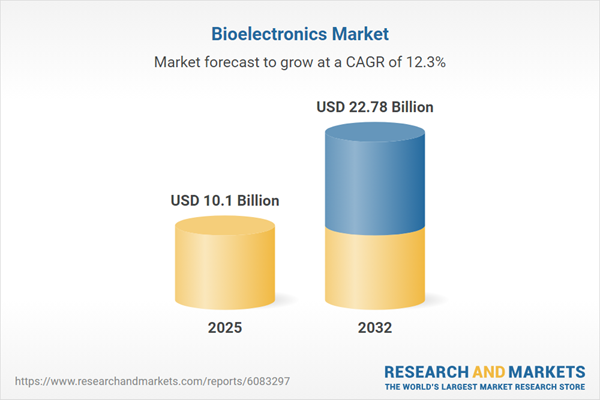Speak directly to the analyst to clarify any post sales queries you may have.
The bioelectronics market is driving the evolution of healthcare delivery through digital transformation and rapid innovation. Senior leaders are leveraging advancements in smart device integration, connectivity, and regulatory progress to enhance operational resilience and pursue sustained growth in a competitive landscape.
Market Snapshot: Bioelectronics Market Growth and Outlook
The global bioelectronics market grew from USD 9 billion in 2024 to USD 10.10 billion in 2025, demonstrating robust expansion and a compound annual growth rate (CAGR) of 12.30%. Projections indicate a market value of USD 22.78 billion by 2032. Growth is underpinned by rising demand for sensor-enabled diagnostics, minimally invasive devices, and digital healthcare platforms. These trends respond to the increasing need for more efficient clinical solutions—driving adoption among major health systems and providers worldwide as they aim to support care innovation across diverse applications.
Scope & Segmentation: Core Domains and Regions in the Bioelectronics Market
- Product Type: Addresses wellness and treatment through home healthcare devices, implantable electronics, ingestible electronics, point-of-care diagnostics, and wearable electronics that streamline management for chronic and acute conditions.
- Technology: Includes biochips, bioelectronic medicines, bioelectronic wearables, biosensors, and neuroprosthetics, enabling improved disease detection, monitoring, and intervention to promote proactive care models.
- Distribution Channel: Spans direct sales, hospital procurement, online sales, and retail pharmacies, supporting comprehensive access across care environments and facilitating efficient market adoption.
- Application: Covers diagnostics, drug delivery, patient monitoring, therapeutics, and fitness and wellness, extending bioelectronic innovations into preventive medicine and targeted interventions.
- End User: Involves academic institutes, hospitals and clinics, pharmaceutical companies, and research laboratories, which play significant roles in the evaluation, adoption, and advancement of bioelectronic technologies.
- Regions Covered: Encompasses the Americas, Europe, Middle East, Africa, and Asia-Pacific. These areas display varied adoption patterns, shaped by regulatory environments, healthcare system maturity, demographics, and care accessibility. Regional policy shifts and infrastructure investments continue to influence adoption and innovation dynamics throughout these markets.
- Companies Profiled: Features leading players such as Medtronic plc, Abbott Laboratories, Boston Scientific Corporation, Siemens Healthineers AG, GE HealthCare Technologies Inc., Koninklijke Philips N.V., and other prominent stakeholders who drive competitive activity across regions and segments.
Key Takeaways: Strategic Insights for Senior Decision-Makers
- Adoption of personalized, adaptive care solutions is increasing as bioelectronic devices—ranging from implants to remote monitoring wearables—provide real-time data for more effective patient management.
- Artificial intelligence and refined sensor technologies are supporting the evolution of closed-loop therapeutic systems, allowing for earlier intervention and improved workflow efficiency as healthcare demands intensify.
- Integrating telehealth capabilities with bioelectronic tools is expanding access to diagnostics and care in underserved and remote locations, helping to optimize patient outcomes and resource allocation.
- Modular design architectures offer resilience against supply chain fluctuations and enable more agile responses to shifting regulatory environments or sourcing requirements.
- Collaboration across manufacturing, software, and healthcare service sectors is accelerating regulatory approval timelines and facilitating faster innovation cycles, supporting broader access to value-based care models.
- Securing robust cybersecurity measures and leveraging clinical validation are proving essential for maintaining product trust and compliance as data-driven healthcare adoption accelerates.
Tariff Impact: Navigating the 2025 Regulatory and Supply Chain Landscape
Recent tariffs in the United States are driving manufacturers to reassess supply chains and sourcing for bioelectronic devices. Organizations are increasing domestic supplier qualification, expanding local assembly, and adopting flexible modular designs to ensure component interchangeability. This shift is contributing to supplier consolidation and encouraging strategic alliances, offering critical support for smaller enterprises managing rising costs and changing duties. Proactive adaptation enables market participants to sustain competitiveness and meet evolving regulatory requirements in a fluid supply environment.
Methodology & Data Sources
This research leverages both primary and secondary data, drawing on regulatory filings, patent information, and interviews with industry and clinical experts. Findings are validated through company- and market-level analysis to ensure accuracy, reliability, and comprehensive coverage across regions.
Why This Report Matters: Actionable Value for Senior Leaders
- Provides structured guidance for product development and risk management, translating regulatory shifts and supply chain trends into practical strategies.
- Delivers targeted analysis on technology deployment and partnership opportunities, enabling organizations to refine competitive approaches within the sector.
- Offers prospective insights into market segmentation and adoption trends by region, supporting strategic resource allocation and long-term planning.
Conclusion
The bioelectronics market signals a new standard of integrated, digitally enabled healthcare. Organizations adopting agile strategies and scalable technology platforms are well-placed to capture growth opportunities and advance outcomes within evolving global health ecosystems.
Table of Contents
3. Executive Summary
4. Market Overview
7. Cumulative Impact of Artificial Intelligence 2025
Companies Mentioned
The companies profiled in this Bioelectronics market report include:- Medtronic plc
- Abbott Laboratories
- Boston Scientific Corporation
- Becton Dickinson and Company
- Siemens Healthineers AG
- GE HealthCare Technologies Inc.
- Koninklijke Philips N.V.
- Edwards Lifesciences Corporation
- ResMed Inc.
- DexCom, Inc.
- Merck KGaA
Table Information
| Report Attribute | Details |
|---|---|
| No. of Pages | 194 |
| Published | October 2025 |
| Forecast Period | 2025 - 2032 |
| Estimated Market Value ( USD | $ 10.1 Billion |
| Forecasted Market Value ( USD | $ 22.78 Billion |
| Compound Annual Growth Rate | 12.3% |
| Regions Covered | Global |
| No. of Companies Mentioned | 12 |









